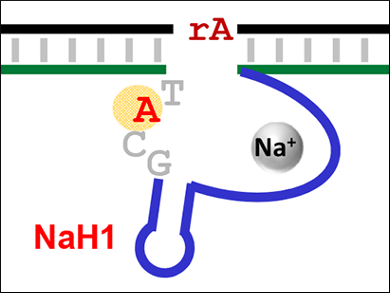Selectively distinguishing sodium from similar metals, such as lithium and potassium, is a challenging task. Juewen Liu and Lingzi Ma, University of Waterloo, Canada, have addressed this challenge using catalytically active DNA molecules, so-called DNAzymes.
The team used a large random DNA library containing hundreds of trillions of DNA sequences. Using an in-vitro selection method, a DNAzyme that is activated by sodium (NaH1, pictured) was found in this library. NaH1 is very similar to the previously reported DNAzyme NaA43 [1]. The two DNAzymes differ only by two nucleotides, but have different pH preferences. NaH1 works optimally at slightly acid conditions (pH 6.0), while NaA43 works optimally at neutral pH.
NaH1 was turned into a fluorescent Na+ biosensor by attaching a fluorophore/quencher pair. These DNAzymes, thus, allow sodium detection under various physiological conditions. Future work will be focused on understanding the biochemical mechanism for the shifted pH preference given the similarity of these two DNAzymes.
- An in Vitro-Selected DNAzyme Mutant Highly Specific for Na+ under Slightly Acidic Conditions,
Lingzi Ma, Juewen Liu,
ChemBioChem 2018.
https://doi.org/10.1002/cbic.201800322
Reference
- [1] In vitro selection of a sodium-specific DNAzyme and its application in intracellular sensing,
Seyed-Fakhreddin Torabi, Peiwen Wu, Claire E. McGhee, Lu Chen, Kevin Hwang, Nan Zheng, Jianjun Cheng, Yi Lu,
Proc. Natl. Acad. Sci. USA 2015, 112, 5903–5908.
https://doi.org/10.1073/pnas.1420361112




